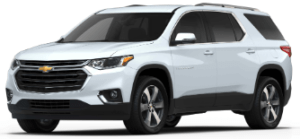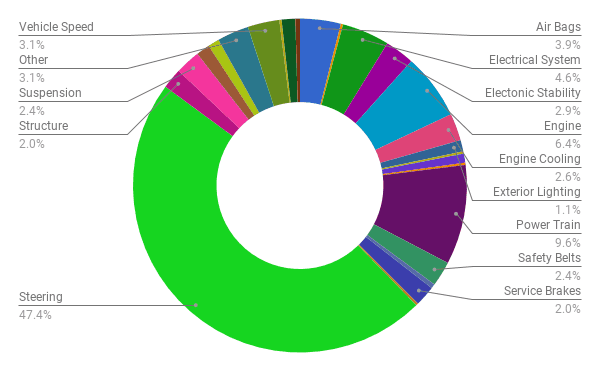This article is intended to help you understand common problems with the 2009 Chevy Traverse. The Chevy Traverse has been around for about 10 years (since 2009). It remained relatively the same stylistically until the 2017 model year, when the second generation made it’s debut.
The goal of this page is to help you make a buying decision if you are questioning whether to buy a used Traverse, or help you diagnose and repair a Traverse that you already own.
It’s much more effective to break problems down by year, as they come and go. Please use the content section directly below to navigate to any specific Traverse Problem, or continue below to find the most commonproblems with the 2009 model year are laid out for you.
Transmission Problems- The transmission problems have been pretty consistent over the entire life of the Chevy Traverse. Here is an entire article on all of the Traverse transmission problems.
Backup Camera- This article will help you troubleshoot if the Traverse backup camera is not working
Traverse Problems Main Hub- All the articles written about Chevy Traverse problems can be found there.
2009 Traverse Problems
2009 was the first model year for the Chevy Traverse. There were 8 documented recalls with the NHTSA. You can see that info below. Directly below is a list of the most common problems that occur with the Traverse.
The chart below shows the 376 complaints made to the NHTSA and organizes them into which ones were the most common problems with the 2009 Chevy Traverse. The most prevalent problems are explained a bit below.
Source: NHTSA
- Steering– Most of the reported problems with steering have to do with the power steering pump. It’ll stop working and make it very difficult to turn the vehicle.
- Power Train– The powertrain is any part from the engine to where it makes contact with the road through the wheels. This is almost a catch-all category and shouldn’t be cause for alarm. It could be a bad transmission or bad axle shafts that are the cause. It can really be a lot of things.
- Engine– 6.4% of all reported problems with the 2009 Chevy Traverse are related to engine issues. Most of the complaints have to do with misfiring or coil failure. Typically a misfire would be caused by a bad coil, so they are most likely one in the same. That’s an easy fix and shouldn’t be cause for alarm.
Recalls: 2009 Traverse
There were 8 total recalls issued on the 2009 Chevrolet Traverse by the NHTSA. They are listed below.
1. Liftgate Struts and Liftgate May Fail
GM Recall Number: 15240
Date Issued: 6/30/2015
Problem– The affected vehicles, equipped with the power lift gate option, have gas struts that hold the power lift gate up when open. These struts may prematurely wear and the open lift gate may suddenly fall.
Solution– GM will notify owners, and dealers will update the software for the power liftgate actuator motor control unit so that the motor will prevent the rapid closing of the lift gate, free of charge.
2. Flexible Steel Cable for Safety Belt May Fail
GM Recall Number: 14187
Date Issued: 5/20/2014
Problem– In the affected vehicles, the flexible steel cable that connects the seatbelt to the front outboard seating positions may fatigue and separate over time. This may cause the seatbelt to not properly restrain the seat occupant, which can cause injury or death.
Solution– General Motors will notify owners, and dealers will inspect and, if necessary, repair and replace the lap pre-tensioner, free of charge.
3. Side Impact Air Bag Wiring Connections
GM Recall Number: 14030
Date Issued: 3/17/2014
Problem– Failure of the side impact air bags and seat belt pretensioners to deploy in a crash increase the risk of injury to the driver and front seat occupant.
Solution– GM will notify owners, and dealers will replace the affected harness connections with soldered connections, free of charge.
4. Second Row Safety Belt Interference
GM Recall Number: N100243
Date Issued: 4/12/2010
Problem– THE SAFETY BELT MAY NOT RESTRAIN THE OCCUPANT AS INTENDED DURING A CRASH, INCREASING THE RISK OF INJURY TO THE SEAT OCCUPANT.
Solution– DEALERS WILL MODIFY THE SECOND ROW SEAT SIDE TRIM SHIELDS. IF A SAFETY BELT BUCKLE IS DAMAGED, DEALERS WILL REPLACE IT FREE OF CHARGE.
5. Heated Windshield Washer Module Short Circuit
NHTSA Campaign Number: 10V240000
Date Issued: 6/04/2010
Problem– IT IS POSSIBLE FOR THE HEATED WASHER MODULE TO IGNITE AND A FIRE MAY OCCUR.
Solution– DEALERS WILL PERMANENTLY DISABLE AND REMOVE THE HEATED WASHER FLUID MODULE. AN UPDATED PAGE FOR THE OWNER MANUAL WILL BE PROVIDED AND INSERTED IN THE OWNER MANUAL TO DOCUMENT THAT THE FEATURE HAS BEEN PERMANENTLY DISABLED AND REMOVED FROM THE VEHICLE.
6. Park Brake Inoperative Fracture Cable Connector
NHTSA Campaign Number: 09V153000
Date: 5/6/2009
Problem– IF THE TRANSMISSION SHIFT LEVER IS IN THE PARK POSITION, THERE WILL BE NO UNINTENDED VEHICLE MOVEMENT. HOWEVER, IF THE KEYS ARE LEFT IN THE IGNITION, THE TRANSMISSION SHIFT LEVER IS IN ANY POSITION OTHER THAN PARK, AND THE VEHICLE IS PARKED ON A SUFFICIENT SLOPE, IT COULD RESULT IN UNINTENDED VEHICLE MOVEMENT. THIS COULD RESULT IN A CRASH WITHOUT PRIOR WARNING.
Solution– DEALERS ARE TO REPLACE THE PARK BRAKE CABLE LINK (CONNECTOR) FREE OF CHARGE.
7. SHIFT LEVER INDICATOR/FMVSS 102 & FMVSS 114
NHTSA Campaign Number: 09V073000
Date: 3/6/2009
Problem– THE DRIVER MAY NOT BE ABLE TO RESTART THE VEHICLE AND THE VEHICLE COULD ROLL AWAY AFTER THE DRIVER HAS EXITED THE VEHICLE, RESULTING IN A POSSIBLE CRASH WITHOUT PRIOR WARNING.
Solution– DEALERS WILL INSPECT AND ENSURE THAT THE SHIFT CABLE ADJUSTMENT CLIP IS FULLY ENGAGED. IN THE EVENT THAT THE CLIP DOES NOT ENGAGE, THE SHIFT CABLE WILL BE REPLACED FREE OF CHARGE.
8. FMVSS 209/SAFETY BELT BUCKLE ASSEMBLY
NHTSA Campaign Number: 08V615000
Date: 11/24/2008
Problem– IN A VEHICLE CRASH, IF THE RIVET IS MISSING, THE BUCKLE MAY SEPARATE FROM THE MOUNTING STRAP, INCREASING THE RISK OF INJURY TO THE PASSENGER.
Solution– DEALERS WILL INSPECT THE SAFETY BELT BUCKLES IN THE SECOND AND THIRD ROWS, AND REPLACE THEM IF NECESSARY.


